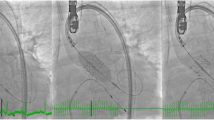Abstract
Aortic valve replacement can produce dramatic benefit in the setting of aortic stenosis. The potential for morbidity and mortality associated with thoracotomy, cardiopulmonary bypass, and aortotomy has fostered a search for alternatives. Early experience with transcatheter endovascular aortic valve implantation demonstrated feasibility and durability, but the procedure was difficult to reproduce. However, equipment, techniques, and experience have evolved rapidly. Balloon-expandable and self-expanding prostheses and percutaneous femoral artery and open left ventricular apical access have found favor, each with potential advantages and disadvantages. Procedural success rates and clinical outcomes continue to improve. Current studies suggest that morbidity and mortality are competitive in comparison to conventional surgery in selected high-risk patients.
Similar content being viewed by others
References and Recommended Reading
Andersen HR, Knudsen LL, Hasenkam JM: Transluminal implantation of artificial heart valves. Description of a new expandable aortic valve and initial results with implantation by catheter technique in closed chest pigs. Eur Heart J 1992, 13:704–708.
Cribier A, Eltchaninoff H, Bash A, et al.: Trans-catheter implantation of balloon-expandable prosthetic heart valves. Early results in an animal model. Circulation 2001, 104(Suppl 2):I552.
Webb JG, Munt B, Makkar RR, et al.: Percutaneous stentmounted valve for treatment of aortic or pulmonary valve disease. Catheter Cardiovasc Interv 2004, 63:89–93.
Bonhoeffer P, Boudjemline Y, Qureshi SA, et al.: Percutaneous insertion of the pulmonary valve. J Am Coll Cardiol 2002, 39:1664–1669.
Cribier A, Eltchaninoff H, Bash A, et al.: Percutaneous transcatheter implantation of an aortic valve prosthesis for calcific aortic stenosis: first human case description. Circulation 2002, 106:3006–3008.
Webb JG, Chandavimol M, Thompson CR, et al.: Percutaneous aortic valve implantation retrograde from the femoral artery. Circulation 2006, 113:842–850.
Webb JG, Pasupati SJ, Humphries K, et al.: Percutaneous transarterial aortic valve replacement in selected high risk patients with aortic stenosis. Circulation 2007, 116:755–763.
Bonow RO, Carabello BA, Kanu C, et al.: ACC/AHA 2006 guidelines for the management of patients with valvular heart disease: a report of the American College of Cardiology/American Heart Association Task Force on Practice Guidelines. Circulation 2006, 114:e84–e231.
Otto CM, Mickel MC, Kennedy JW, et al.: Three-year outcome after balloon aortic valvuloplasty: insights into prognosis of valvular aortic stenosis. Circulation 1994, 89:642–650.
Lieberman EB, Bashore TM, Hermiller JB, et al.: Balloon aortic valvuloplasty in adults: failure of procedure to improve long-term survival. J Am Coll Cardiol 1995, 26:1522–1528.
Feldman T: Core curriculum for interventional cardiology: percutaneous valvuloplasty. Catheter Cardiovasc Interv 2003, 60:48–56.
Goodney PP, O’Connor GT, Wennberg DE, et al.: Do hospitals with low mortality rates in coronary artery bypass also perform well in valve replacement? Ann Thorac Surg 2003, 76:1131–1136.
Task Force on the Management of Valvular Heart Disease of the European Society of Cardiology. Guidelines on the management of valvular heart disease [no authors listed]. Eur Heart J 2007, 428:e1–e39.
Iung B, Baron G, Butchart EG, et al.: A prospective survey of patients with valvular heart disease in Europe: the Euro Heart Valve Survey on Valvular Disease. Eur Heart J 2003, 24:1231–1243.
Nkomo VT, Gardin JM, Skelton TN, et al.: Burden of valvular heart diseases: a population-based study. Lancet 2006, 368:1005–1011.
Cribier A, Eltchaninoff H, Tron C, et al.: Early experience with percutaneous transcatheter implantation of heart valve prosthesis for the treatment of end-stage inoperable patients with calcific aortic stenosis. J Am Coll Cardiol 2004, 43:698–703.
Ye J, Cheung A, Lichtenstein SV, et al.: Transapical aortic valve implantation in humans. J Thorac Cardiovasc Surg 2006, 131:1194–1196.
Cribier A, Eltchaninoff H, Tron C, et al.: Percutaneous implantation of aortic valve prosthesis in patients with calcific aortic stenosis: technical advances, clinical results and future strategies. J Invasive Cardiol 2006, 19:S88–S96.
Hanzel GS, Harrity PJ, Schreiber TL, et al.: Retrograde percutaneous aortic valve implantation for critical aortic stenosis. Catheter Cardiovasc Interv 2005, 64:322–326.
Webb JG, Pasupati S, Achtem L, et al.: Rapid pacing to facilitate transcatheter prosthetic heart valve implantation. Catheter Cardiovasc Interv 2006, 68:199–204.
Grube E, Schuler G, Buellesfeld L, et al.: Percutaneous aortic valve replacement for severe aortic stenosis in high-risk patients using the second-and current-third generation self-expanding CoreValve prosthesis: device success and 30-day outcome. J Am Coll Cardiol 2007, 50:69–76.
Grube E, Laborde JC, Zickmann B, et al.: First report on a human percutaneous transluminal implantation of a self-expanding valve prosthesis for interventional treatment of aortic valve stenosis. Catheter Cardiovasc Interv 2005, 66:465–469.
Grube E, Laborde JC, Gerckens U, et al.: Percutaneous implantation of the CoreValve self-expanding valve prosthesis in high-risk patients with aortic valve disease: the Siegburg first-in-man study. Circulation 2006, 114:1616–1624.
Berry C, Asgar A, Lamarche Y, et al.: Novel therapeutic aspects of percutaneous aortic valve replacement with the CoreValve Revalving System. Cathet Cardiovasc Interv 2007, 70:610–616.
Ye J, Cheung A, Lichtenstein SV, et al.: Six-month outcome of transapical transcatheter aortic valve implantation in the initial seven patients. Eur J Cardiothorac Surg 2007, 31:16–21.
Lichtenstein SV, Cheung A, Ye J, et al.: Transapical transcatheter aortic valve implantation in humans: initial clinical experience. Circulation 2006, 114:591–596.
Moss RR, Ivens E, Pasupati S, et al.: Echocardiography and percutaneous aortic valve implantation. J Am Coll Cardiol 2007, In press.
Author information
Authors and Affiliations
Corresponding author
Rights and permissions
About this article
Cite this article
Webb, J.G. Percutaneous aortic valve replacement. Curr Cardiol Rep 10, 104–109 (2008). https://doi.org/10.1007/s11886-008-0019-z
Published:
Issue Date:
DOI: https://doi.org/10.1007/s11886-008-0019-z




